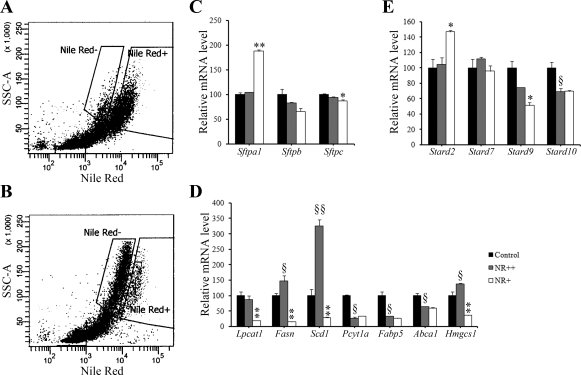Fig. 8.
Deletion of Abca3 induces compensatory mechanisms in both type II cell populations present in adult Abca3Δ/Δ mice. Flow cytofluorometric data of alveolar type II cells from adult control (A) and Abca3Δ/Δ (B) mice stained with Nile red (NR) showed 1 cell population with high fluorescence intensity (NR++) and 1 cell population with lower fluorescence intensity (NR+). mRNAs were extracted from alveolar type II cells isolated from adult control or Abca3Δ/Δ mice and sorted according to NR fluorescence intensity. SSC-A, side-scatter area. Quantitative RT-PCR was performed to estimate gene mRNA levels for surfactant-associated proteins (C; Sftpa1, Sftpb, and Sftpc), lipid metabolism (D; Fasn, Scd1, Lpcat1, Pcyt1a, Fabp5, Abca1, and Hmgcs1), or members of the START domain superfamily (E; Stard2, Stard7, Stard9, and Stard10). Sftpa1 and Stard2 were significantly increased in NR+ cells compared with control and NR++ cells. Fasn, Scd1, Lpcat1, Pcyt1a, and Hmgcs1 were significantly reduced in NR+ cells compared with control and NR++ cells. Fasn, Scd1 and Hmgcs1 were significantly increased in NR++ cells compared with control cells. Results were normalized to 18S rRNA and are representative of 4 animals per group. *P < 0.05 and **P < 0.01 vs. NR++ cells. §P < 0.05 and §§P < 0.01 vs. control cells.

